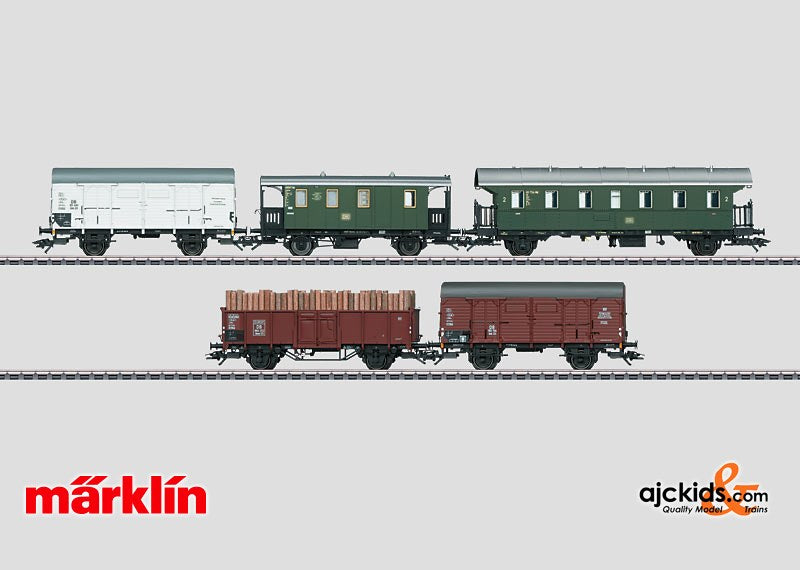Marklin 48816 - Freight Car Set Donnerbuchse and freight
Prototype: 5 different German Federal Railroad (DB) car for a freight train with passenger accommodations (GmP). 1 type Bie "Donnerbüchse" / "Thunderbox" passenger car, 2nd class, 1 type LpwPost baggage car, 1 type Geh 20 boxcar in a reddish brown paint scheme (former Bavarian milk car), 1 type Geh 20 boxcar in a grayish white paint scheme (former Bavarian milk car), 1 type Omms55 gondola. All of the cars look as they did around 1958.
Model: The type Geh 20 boxcar (former Bavarian milk car) does not have a handbrake, does have a curved roof, and heating couplings. There are 2 separately applied steps below the sliding doors. The gondola has truss rods but no handbrake. It is loaded with mine timber. All of the cars have different car numbers and are individually packaged and marked. Total length over the buffers 61.3 cm / 24-1/8".
DC wheel set per car 2 x 700580 and 2 x 32376004 (baggage car).
Highlights:
- The former Bavarian design two-axle milk car with a curved roof is new tooling.
- Typical freight train with passenger accommodations (GmP).
One-time series.
Bavarian Design Milk Cars around 1958 Special freight cars were purchased in Bavaria for milk transport service and above all especially for the transport of milk cans. The railroad transported milk cans in this manner from Bavarian dairy farmers who brought their products by wagon or tractor to the nearest station. The cars ran in scheduled passenger trains, which in those days enabled the fastest possible transport of perishable milk to the dairies in the city. Not until milk transport increasingly went over to truck transport at the end of the Fifties, beginning of the Sixties did the milk transport cars become superfluous. They then were given other jobs such as less-than-carload freight service. The light paint scheme was characteristic for these cars and was supposed to keep temperatures inside within limits. Another typical feature was the two narrow, opposed sliding doors on both sides. Since the cars were not loaded by forklift or hand truck, narrow doors worked out well.
A load conductor or local personnel or even the farmer delivering the milk took care of manually loading the 40 liter / 10.5 gallon milk cans. There were several load restraints inside to secure the milk cans. The loading work at the short stops for the passenger trains could be taken care of relatively quickly through the two doors on both sides of the cars. In addition, the milk cans to be unloaded could be pre-sorted during the trip and be placed ready for unloading at one of the doors. Since the milk transport car was run in passenger trains as a rule, it had a Westinghouse design air brake as well as electrical and steam heating lines. This allowed passenger cars running behind the milk car to be heated too. The wooden boards on the ends of the car had slots in them to allow wind to whistle into the car's interior in order to keep the milk somewhat cool during the trip. Riding in a milk transport car thus developed into a drafty experience.
The class 64 and 86 tank locomotives go well as motive power with this freight car set.
EAN/UPC: 4001883488165



